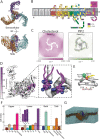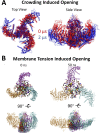Computational studies of Piezo1 yield insights into key lipid-protein interactions, channel activation, and agonist binding
- PMID: 35340596
- PMCID: PMC8921400
- DOI: 10.1007/s12551-021-00847-0
Computational studies of Piezo1 yield insights into key lipid-protein interactions, channel activation, and agonist binding
Abstract
Piezo1 is a mechanically gated ion channel responsible for converting mechanical stimuli into electrical signals in mammals, playing critical roles in vascular development and blood pressure regulation. Dysfunction of Piezo1 has been linked to several disorders, including hereditary xerocytosis (gain-of-function) and generalised lymphatic dysplasia (loss-of-function), as well as a common polymorphism associated with protection against severe malaria. Despite the important physiological roles played by Piezo1, its recent discovery means that many aspects underlying its function are areas of active research. The recently elucidated cryo-EM structures of Piezo1 have paved the way for computational studies, specifically molecular dynamic simulations, to examine the protein's behaviour at an atomistic level. These studies provide valuable insights to Piezo1's interactions with surrounding membrane lipids, a small-molecule agonist named Yoda1, and Piezo1's activation mechanisms. In this review, we summarise and discuss recent papers which use computational techniques in combination with experimental approaches such as electrophysiology/mutagenesis studies to investigate Piezo1. We also discuss how to mitigate some shortcomings associated with using computational techniques to study Piezo1 and outline potential avenues of future research.
Keywords: Channel activation; Computational techniques; Piezo1.
© International Union for Pure and Applied Biophysics (IUPAB) and Springer-Verlag GmbH Germany, part of Springer Nature 2021.
Figures



References
-
- Andolfo I, Alper SL, De Franceschi L, Auriemma C, Russo R, De Falco L, Vallefuoco F, Esposito MR, Vandorpe DH, Shmukler BE, Narayan R, Montanaro D, D’Armiento M, Vetro A, Limongelli I, Zuffardi O, Glader BE, Schrier SL, Brugnara C, Stewart GW, Delaunay J, Iolascon A. Multiple clinical forms of dehydrated hereditary stomatocytosis arise from mutations in PIEZO1. Blood. 2013;121(19):3925–3935. doi: 10.1182/blood-2013-02-482489. - DOI - PubMed
Publication types
LinkOut - more resources
Full Text Sources

